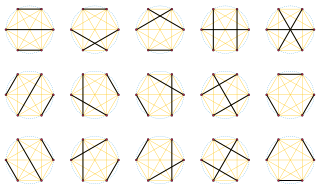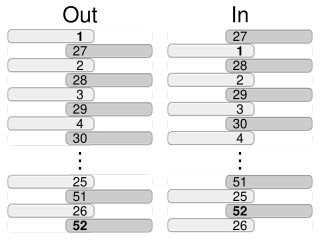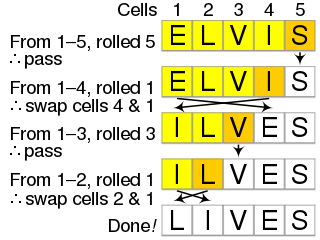
In mathematics, the discrete Fourier transform (DFT) converts a finite sequence of equally-spaced samples of a function into a same-length sequence of equally-spaced samples of the discrete-time Fourier transform (DTFT), which is a complex-valued function of frequency. The interval at which the DTFT is sampled is the reciprocal of the duration of the input sequence. An inverse DFT (IDFT) is a Fourier series, using the DTFT samples as coefficients of complex sinusoids at the corresponding DTFT frequencies. It has the same sample-values as the original input sequence. The DFT is therefore said to be a frequency domain representation of the original input sequence. If the original sequence spans all the non-zero values of a function, its DTFT is continuous, and the DFT provides discrete samples of one cycle. If the original sequence is one cycle of a periodic function, the DFT provides all the non-zero values of one DTFT cycle.

Shuffling is a procedure used to randomize a deck of playing cards to provide an element of chance in card games. Shuffling is often followed by a cut, to help ensure that the shuffler has not manipulated the outcome.

In mathematics, a permutation of a set can mean one of two different things:
In combinatorial mathematics, the Bell numbers count the possible partitions of a set. These numbers have been studied by mathematicians since the 19th century, and their roots go back to medieval Japan. In an example of Stigler's law of eponymy, they are named after Eric Temple Bell, who wrote about them in the 1930s.
In mathematics, a stochastic matrix is a square matrix used to describe the transitions of a Markov chain. Each of its entries is a nonnegative real number representing a probability. It is also called a probability matrix, transition matrix, substitution matrix, or Markov matrix. The stochastic matrix was first developed by Andrey Markov at the beginning of the 20th century, and has found use throughout a wide variety of scientific fields, including probability theory, statistics, mathematical finance and linear algebra, as well as computer science and population genetics. There are several different definitions and types of stochastic matrices:
In mathematics, particularly in matrix theory, a permutation matrix is a square binary matrix that has exactly one entry of 1 in each row and each column with all other entries 0. An n × n permutation matrix can represent a permutation of n elements. Pre-multiplying an n-row matrix M by a permutation matrix P, forming PM, results in permuting the rows of M, while post-multiplying an n-column matrix M, forming MP, permutes the columns of M.

In combinatorics, the inclusion–exclusion principle is a counting technique which generalizes the familiar method of obtaining the number of elements in the union of two finite sets; symbolically expressed as

In mathematics, the double factorial of a number n, denoted by n‼, is the product of all the positive integers up to n that have the same parity as n. That is,
In linear algebra, a circulant matrix is a square matrix in which all rows are composed of the same elements and each row is rotated one element to the right relative to the preceding row. It is a particular kind of Toeplitz matrix.
In mathematics, especially in combinatorics, Stirling numbers of the first kind arise in the study of permutations. In particular, the unsigned Stirling numbers of the first kind count permutations according to their number of cycles.
A complex Hadamard matrix is any complex matrix satisfying two conditions:
In mathematics, especially in linear algebra and matrix theory, the commutation matrix is used for transforming the vectorized form of a matrix into the vectorized form of its transpose. Specifically, the commutation matrix K(m,n) is the nm × mn matrix which, for any m × n matrix A, transforms vec(A) into vec(AT):

The faro shuffle (American), weave shuffle (British), or dovetail shuffle is a method of shuffling playing cards, in which half of the deck is held in each hand with the thumbs inward, then cards are released by the thumbs so that they fall to the table interleaved. Diaconis, Graham, and Kantor also call this the technique, when used in magic.
In quantum mechanics, an antisymmetrizer is a linear operator that makes a wave function of N identical fermions antisymmetric under the exchange of the coordinates of any pair of fermions. After application of the wave function satisfies the Pauli exclusion principle. Since is a projection operator, application of the antisymmetrizer to a wave function that is already totally antisymmetric has no effect, acting as the identity operator.

The Fisher–Yates shuffle is an algorithm for shuffling a finite sequence. The algorithm takes a list of all the elements of the sequence, and continually determines the next element in the shuffled sequence by randomly drawing an element from the list until no elements remain. The algorithm produces an unbiased permutation: every permutation is equally likely. The modern version of the algorithm takes time proportional to the number of items being shuffled and shuffles them in place.

In computer science and discrete mathematics, an inversion in a sequence is a pair of elements that are out of their natural order.
In mathematics, the Robinson–Schensted–Knuth correspondence, also referred to as the RSK correspondence or RSK algorithm, is a combinatorial bijection between matrices A with non-negative integer entries and pairs (P,Q) of semistandard Young tableaux of equal shape, whose size equals the sum of the entries of A. More precisely the weight of P is given by the column sums of A, and the weight of Q by its row sums. It is a generalization of the Robinson–Schensted correspondence, in the sense that taking A to be a permutation matrix, the pair (P,Q) will be the pair of standard tableaux associated to the permutation under the Robinson–Schensted correspondence.
In the mathematics of permutations and the study of shuffling playing cards, a riffle shuffle permutation is one of the permutations of a set of items that can be obtained by a single riffle shuffle, in which a sorted deck of cards is cut into two packets and then the two packets are interleaved. Beginning with an ordered set, mathematically a riffle shuffle is defined as a permutation on this set containing 1 or 2 rising sequences. The permutations with 1 rising sequence are the identity permutations.
In the mathematics of shuffling playing cards, the Gilbert–Shannon–Reeds model is a probability distribution on riffle shuffle permutations. It forms the basis for a recommendation that a deck of cards should be riffled seven times in order to thoroughly randomize it. It is named after the work of Edgar Gilbert, Claude Shannon, and J. Reeds, reported in a 1955 technical report by Gilbert and in a 1981 unpublished manuscript of Reeds.
Norman Laurence Gilbreath is an American magician and author known for originating the Gilbreath shuffle. He is also known for Gilbreath's conjecture concerning prime numbers.























